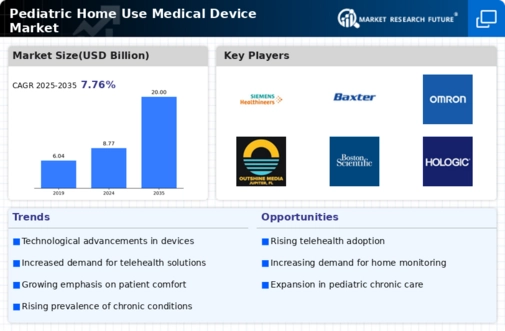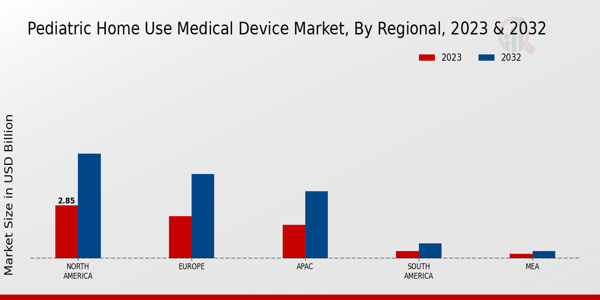Government Initiatives and Support
Government initiatives aimed at improving pediatric healthcare access and affordability are pivotal for the Global Pediatric Home Use Medical Device Market Industry. Various countries are implementing policies that promote the use of home healthcare solutions, including subsidies for medical devices and funding for research and development. Such initiatives not only enhance the accessibility of pediatric home medical devices but also encourage innovation within the industry. As governments recognize the importance of early intervention and continuous monitoring, the market is likely to benefit from increased investment and support, fostering a conducive environment for growth.
Increased Parental Awareness and Involvement
Increased parental awareness regarding child health and wellness significantly influences the Global Pediatric Home Use Medical Device Market Industry. Parents are becoming more proactive in managing their children's health, often seeking devices that facilitate home monitoring and treatment. This trend is evident in the rising sales of home-use devices such as nebulizers and glucose monitors. As parents prioritize their children's health, the demand for reliable and effective home medical devices is likely to grow. This shift in consumer behavior is expected to contribute to a compound annual growth rate of 7.77% from 2025 to 2035.
Technological Advancements in Medical Devices
Technological advancements play a crucial role in shaping the Global Pediatric Home Use Medical Device Market Industry. Innovations such as telemedicine, wearable devices, and smart monitoring systems enhance the efficiency and effectiveness of home healthcare. These technologies enable real-time data collection and remote patient monitoring, which can lead to improved health outcomes for children. As parents increasingly seek user-friendly and efficient devices, the market is likely to expand. The anticipated growth trajectory suggests that by 2035, the market could reach 20.0 USD Billion, reflecting the potential impact of these advancements.
Rising Prevalence of Pediatric Chronic Conditions
The Global Pediatric Home Use Medical Device Market Industry experiences growth driven by the increasing prevalence of chronic conditions among children. Conditions such as asthma, diabetes, and obesity are becoming more common, necessitating the use of home medical devices for monitoring and management. For instance, the rise in childhood obesity has led to a greater demand for devices that assist in weight management and health monitoring. This trend is expected to contribute significantly to the market, which is projected to reach 8.77 USD Billion in 2024, indicating a strong need for innovative solutions in pediatric healthcare.
Growing Demand for Cost-Effective Healthcare Solutions
The demand for cost-effective healthcare solutions is a significant driver of the Global Pediatric Home Use Medical Device Market Industry. As healthcare costs continue to rise, families are increasingly seeking affordable alternatives to traditional healthcare settings. Home medical devices offer a practical solution by enabling parents to monitor and manage their children's health from home, potentially reducing hospital visits and associated costs. This trend is particularly relevant in regions with limited access to healthcare facilities. The market's growth reflects this shift towards home-based care, aligning with broader healthcare trends emphasizing efficiency and cost-effectiveness.























Leave a Comment